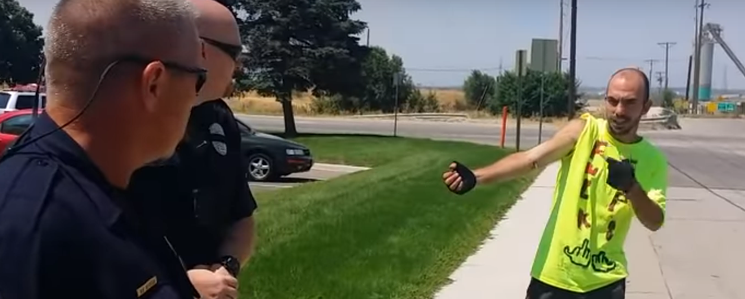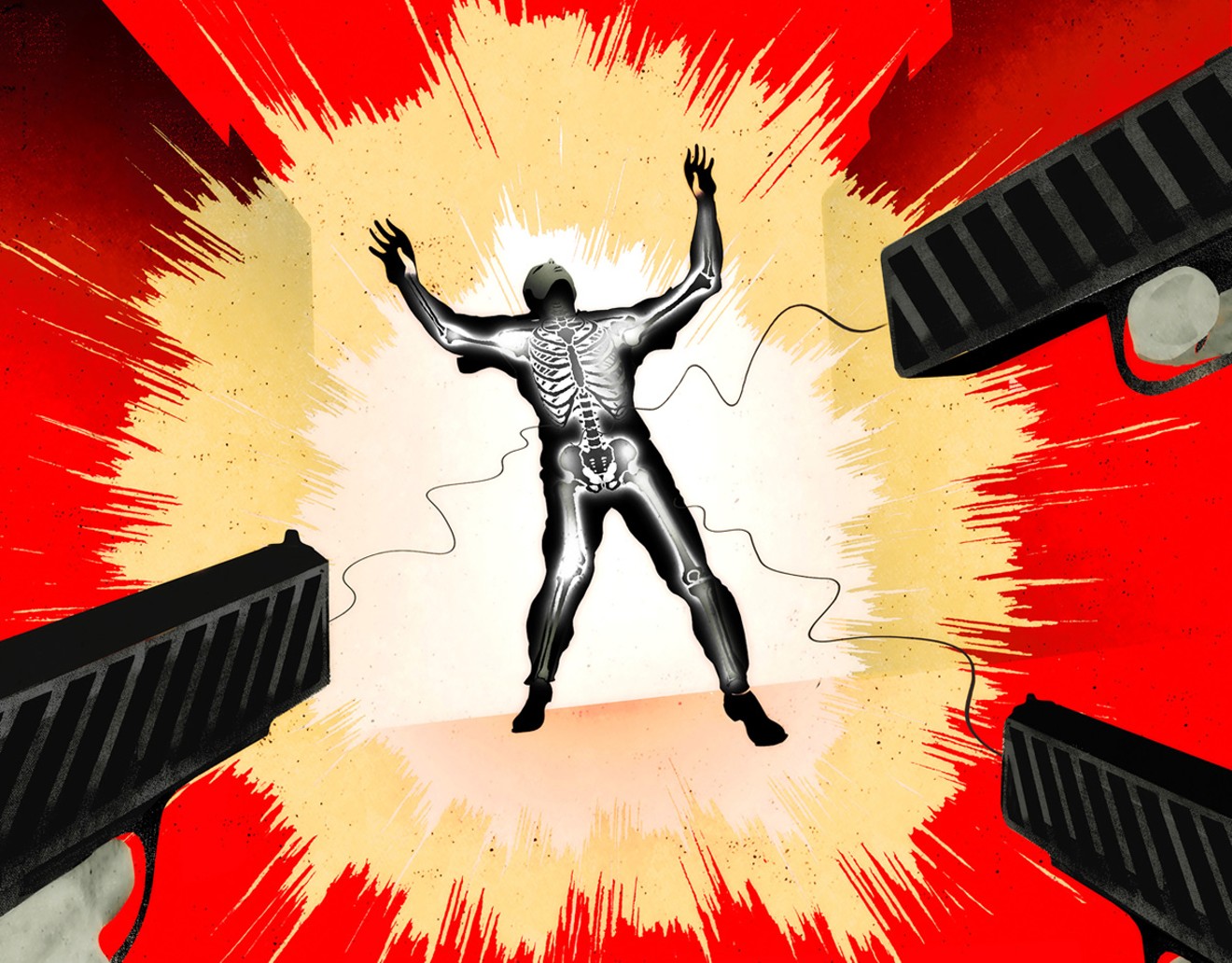Elaine Holt knows that the story sounds strange. It was stranger still, she says, to watch the whole sorry business unfold outside her home: The man in her yard, looking for people who didn’t exist, then wandering off and shouting. The distant gunshots. The sheriff’s deputies carrying the man away, the life ebbing out of him.
You can talk all you want about proper police procedure, reasonable use of force, de-escalation training, and so on. But it comes down to this: The man, a combat veteran and certified war hero, needed help. Holt knew it. The man knew it. A neighbor supposedly heard him say as much, standing in a field with his arms raised and addressing the arriving sheriff’s officers: “I’m a vet. I’m a vet. I need help.”
Whether the deputies heard him, whether the exchange even happened that way, remains unclear. This is what Elaine Holt knows: Christopher Matthew Poer called the police for assistance in a moment of crisis, and their response cost him his life.
Poer, known to his friends as Matt, had seen action in Iraq and Afghanistan as a staff sergeant of the 5th Special Forces Group. The 46-year-old ex-Green Beret paid dearly for his service, both in body and spirit. Surgery for his active-duty injuries resulted in infections and other complications, damaging his heart, lungs and kidneys. The horror of what he’d experienced left him battling anxiety, depression and other symptoms of post-traumatic stress disorder. “If I crash, tell the doc I suffer from pulmonary edema, acute respiratory failure and heart failure,” he texted to Holt the day before his death. “Also a healthy dose of alcoholism.”
Right up until the end, Holt had regarded Matt Poer as a stable, gentle individual, a genuine good guy. He’d contacted her last spring from his home in Rhode Island about purchasing a dog. Holt breeds and trains German shepherds at her home in rural Elbert County, a fifteen-minute drive from the southeast fringes of Aurora, and Poer was looking for a service dog to help him with his PTSD, a replacement for a German shepherd named Dano who’d recently died. After talking with Holt on the phone several times about her service canines, Poer had come out to her place to work with two dogs and decide which one would be the best fit.
Poer stayed on the property for several days without incident. On Wednesday, April 11, he told Holt he wasn’t feeling well. She offered to drive him to a doctor, but he said he didn’t want to die in a hospital. “He had gone off his meds, for whatever reason,” Holt recalls. “But he specifically said, ‘I am not suicidal.’”

Matt Poer received a Bronze Star while serving in Special Forces in Afghanistan.
Courtesy of Sherry Poer
When they returned to the house, Holt says, “He was pointing out different things that he said were cameras or recording devices. He took apart my patio umbrella, saying it’s an antenna. He was acting very off, but not to the point where I felt threatened.”
Poer continued to fret about surveillance throughout the afternoon. He called the Elbert County Sheriff's Office to report the cameras. A sergeant returned the call an hour later, got voicemail, and left a message. Frustrated that the police hadn’t responded by sending a car, Poer called 911 — and handed the phone to Holt.
While Poer went poking around the RV again, Holt explained to the dispatcher that her guest seemed to be having a delusional episode. As far as she knew, he hadn’t been drinking or doing any drugs, but he had taken her handgun, a .380 Sig Sauer, and it was loaded. Watching from her bedroom window, Holt could see Poer leave the RV, cross the road and disappear into a field.
Neighbors saw a man wandering in the field, shouting and waving a gun around. He fired into the air several times, mumbled, tripped, got up again. Shortly before eight o’clock, three deputies arrived in the gathering dusk. They heard gunfire and approached cautiously.
“I can hear him yelling,” sheriff’s deputy Christopher Dickey informed the dispatcher. “He sounds intoxicated… . I’ve lost sight of him, but I can still hear him.”
A few minutes later, Dickey was back on the radio, reporting that he had the suspect in custody. At first the officers stated that they didn’t need medical help, then they said they did. Holt saw the deputies barrel by in a truck, performing chest compressions on Poer in the truck bed and rushing to meet emergency medical personnel. He was pronounced dead at a local hospital 45 minutes later.
The official autopsy report attributes Poer’s death to a combination of three factors. He suffered from dilated cardiomyopathy, an enlarged heart. He had a near-fatal level of amphetamines in his system, a mystery that confounds his friends and family members; Holt says he told her that day that he’d rummaged around in her medicine cabinet and had taken two tablets of Adderall, but he would have had to take a much higher dosage to achieve that level of stimulant in his blood.
The third factor was the police use of a Taser to subdue Poer. According to the autopsy report, the medical examiner reviewed police body-camera footage from the scene: “Taser deployment can be heard, followed immediately by a groaning sound by the subject and immediate unresponsiveness, from which he never regains consciousness.” The manner of death was ruled a homicide — which, in coroner circles, means the death was caused, at least in part, by human action.
Such a finding doesn’t impute any criminal culpability to the officers involved. In October, the 18th Judicial District Attorney’s Office released its review of Poer’s death, concluding that the officers used “reasonable and appropriate” force, given that they were dealing with an oddly behaving suspect armed with a deadly weapon. But in defending the use of a Taser, a form of “less-than-lethal force,” Chief Deputy District Attorney Elizabeth Oldham directly contradicted the autopsy report’s description of what happened. “Even after being subjected to the Taser device, Mr. Poer continued to resist,” her report asserts.
Witness accounts of the incident are also at odds with the account provided in Oldham’s review. The actual body-camera footage would, perhaps, resolve the points of dispute, but Elbert County Sheriff Shayne Heap has refused to release the body-cam recordings, saying that to do so would reveal confidential police tactics, violate the privacy of the dead man and his family (even though it was the family’s attorney who requested their release), compromise an “ongoing investigation,” and taint the jury pool in the anticipated future litigation over Poer’s death."You never have any officers get in trouble for anything...But I 'd like to see the body-cam footage and judge that situation for myself."
tweet this
Heap says he’s satisfied, based on his own review of the situation, that his officers acted appropriately. “I think those gentlemen went above and beyond the call,” he says, “and did everything they could to bring that situation to a peaceful resolution.”
David Fisher, the attorney representing Poer’s parents, says he’s not surprised by Oldham’s findings or the sheriff’s decision not to release the footage. “It’s exactly what I expected,” he says. “You never have any officers get in trouble for anything. I get it that there were extenuating circumstances. But I’d like to see the body-cam footage and judge that situation for myself.”
The questions surrounding Poer’s death reflect a larger national debate over whether law enforcement has become too reliant on Tasers as a “less-than-lethal” use of force. Several studies have found that, while certainly less deadly than firearms, Tasers aren’t as benign as they are often represented to be. Last year a Reuters investigation documented more than a thousand deaths in the United States related to police Taser use since the early 2000s, resulting in at least $172 million in payouts to settle wrongful death lawsuits. Taser International, the company that makes the stun guns, no longer characterizes them as “non-lethal” and advises officers against using them in situations involving suspects who exhibit “extreme agitation” or have a heart condition.
Tasers can be particularly dangerous in the hands of untrained, overzealous or highly impulsive officers — the ones who tend to shock first and ask questions later. The deputy who tased Poer, Chris Dickey, is a veteran cop who put in many years in the Denver area before moving to Elbert County in 2017, but his record includes several citizen complaints over alleged excessive force, including Taser use. None of the allegations ever led to formal disciplinary action against Dickey, though two of the incidents have generated lawsuits in federal court. In one of those cases, Dickey’s former employer, the Commerce City Police Department, recently agreed to pay $775,000 to a motorist who was severely beaten and tased by Dickey and other officers during a 2014 traffic stop. The attorney for the plaintiff in that case was David Fisher, who is now representing Poer’s parents.
“Cops like Chris Dickey give all the good guys a bad name,” says Sherry Poer, Matt’s mother, speaking by phone from her home in Indiana. “My son was a casualty of war. His health suffered. He did have PTSD. But he didn’t hurt people. He was lying down when they got to him. All they had to do was cuff him and take him to a hospital.”
Sherry Poer has read the autopsy report, the Oldham report clearing the officers involved, the sheriff’s letter refusing to let her see the body-cam footage. She has plenty of questions.
“They’re not telling us everything,” she says. “It’s nothing but a coverup. And that’s the worst part. It’s worse than losing him. We’ve heard stories on TV about bad cops, but this is beyond our imagination. They think they can just say what they want.”

Former Commerce City police officer Chris Dickey (above) maintained that the force used during a 2014 traffic stop to arrest Carl Leadholm was “reasonable and necessary.”
U.S. District Court of Colorado
The last thing he remembers with any clarity is driving east on Interstate 70 and seeing a sign for the exit to I-225. Leadholm had just finished work for the day at a paper-recycling plant and was headed for home in southeast Aurora. Toward the end of his shift he’d felt a headache coming on, but hadn’t paid it much attention.
Then come the still frames. His car is pulled to the side of the road, somewhere in the boondocks, and there’s a police officer approaching him, yelling at him. Leadholm smiles at him. The next thing he knows he’s handcuffed by the side of the road. His hands are numb, his face bloody and on fire from pepper spray.
“I remember several voices raging at me,” Leadholm recalls. “As my consciousness was coming back, I said, ‘I’m sorry, I’m diabetic.’ They said, ‘Bullshit. If you were diabetic you wouldn’t be fighting us’ — that was their word.”
Diagnosed with Type I diabetes at age six, Leadholm was long accustomed to monitoring and managing his condition. Unfortunately, the day he encountered Chris Dickey and other members of the Commerce City Police Department, he was in the middle of a medical emergency. His blood glucose level was crashing, leading to confusion and the risk of seizures or a coma. But the officers involved didn’t realize they were dealing with a man in critical need of a sugar fix. They suspected him of being drunk.
Responding to citizen calls about an erratic driver heading north on Tower Road, Dickey observed Leadholm’s car weaving across lanes and almost scraping a guard rail. He put on his lights and pulled the suspect over near 120th Avenue. He approached the car and ordered Leadholm to put the car in park. Leadholm smiled at him.“Not one of them had to beat or tase me. But these officers went straight to that.”
tweet this
Dickey reached into the car, opened the driver’s door, removed Leadholm’s seat belt and pulled him out. The car started to roll, forcing Dickey to move quickly to put it in park. In a deposition three years later, Dickey acknowledged that Leadholm didn’t smell of alcohol, but he said that the suspect was “tensing up on me” as he attempted to cuff him, so he took him down to the pavement.
Leadholm curled up into a fetal position. With the aid of other officers, Dickey wrestled him onto his stomach. Another officer blasted three doses of pepper spray into Leadholm’s face. Dickey whacked him in the calf with an aluminum baton. Then he tased him five times, for a total of 24 seconds. (Tasers typically deliver up to five-second bursts of electricity; a 2011 Department of Justice report urges law enforcement officers to refrain “from continuous activations of greater than 15 seconds.”)
Paramedics soon arrived, found Leadholm’s glucose level to be dangerously low, and administered glycogen. His injuries weren’t as easily fixed. He had scrapes on his face from being pressed into the asphalt, a gash under his chin, bruises from being hit with the baton. The bones in the middle finger of his left hand were so badly shattered that surgeons had to put in an artificial joint, to be replaced every ten years. “I have a hard time leaving the house now,” says Leadholm, who now lives in Idaho. “My life is not what it was before.”

Carl Leadholm recently settled his lawsuit against Dickey and Commerce City for $775,000.
U.S. District Court of Colorado
In his deposition, Dickey maintained that the force used on Leadholm was “reasonable and necessary.” He explained that there’s a fine line between what he considers “defensive resistance” and “active aggression,” and Leadholm had crossed that line by trying to kick him — a detail that isn’t included in Dickey’s report of the incident. (None of the officers were wearing body cameras that could confirm that account.) Although he doesn’t remember much of what happened, Leadholm doubts he kicked anybody and says he’s never behaved violently during a diabetic episode. The officers never tried to determine what was wrong with him, he says, before unloading on him.
“Not one of them had to beat or tase me,” he says. “But these officers went straight to that.”
Leadholm stresses that he has great respect for most police officers. But not Chris Dickey. “He’s a bully,” he says. “He just wants to go out there and inflict punishment. He thinks it’s his job to execute justice, and that’s not okay.” (Through his attorney, Dickey declined to comment for this article.)
Although the treatment of Leadholm led to a civil-rights lawsuit and a costly settlement, it was never formally investigated by the Commerce City Police Department as a possible improper use of force. The incident was “reviewed” internally, but Leadholm was never interviewed, and none of the officers involved were disciplined or ordered to take additional training. Fisher and other civil-rights attorneys say such a response was typical in the CCPD, which had a reputation for turning a blind eye to questionable displays of force by its officers. Another lawsuit claims that there were at least 250 citizen complaints alleging excessive force by Commerce City police officers between 2010 and 2014 — but not one of those complaints led to anyone being disciplined for violating the CCPD’s policies regarding use of force.

The injuries to Leadholm's left hand from the traffic stop were so severe that surgeons ended up placing an artificial joint in the middle finger.
U.S. District Court of Colorado
In 2011, the CCPD police union prepared a 23-page report that called for an official investigation into a range of allegations about misconduct by individual officers and mismanagement by police administration. Little came of that effort, but in 2013 Troy Smith, the department’s chief at the time, began a push for a range of reform measures, including increased “accountability.” In 2016, Commerce City Mayor Sean Ford took the unusual step of formally requesting a review of the reform efforts by the U.S. Department of Justice, through the DOJ’s Office of Community Oriented Policing Services.
“Serious internal issues and officer misconduct have been all too prevalent in the department over a prolonged period of time,” Ford wrote in his letter to the DOJ. “For example, within the last six months, two officers were criminally charged for their actions while on duty. In other cases, officers have chosen to resign during the internal affairs investigative process after having been found to have engaged in conduct that likely would have resulted in termination.”
By the time the reform movement was gaining steam, Chris Dickey had been a Commerce City police officer for more than a decade. He had an associate degree in criminal justice, a four-year degree in business management, and no adverse findings on his record concerning any use-of-force incidents. But he’d also had four citizen complaints filed against him over a four-year period, in addition to the Leadholm lawsuit.
Brief summaries of those complaints appear in lawsuits filed against Dickey and the CCPD. One was from a semi-truck driver who claimed that Dickey had yanked him out of the driver’s seat during a routine traffic stop, ordered him to spread his hands against the truck in a search position, and then struck him in the neck with a baton, causing him to lose consciousness.“Serious internal issues and officer misconduct have been all too prevalent in the department over a prolonged period of time.”
tweet this
Another complainant said that Dickey tased him during a traffic stop, then pulled him from the vehicle and tased him again.
A woman alleged that Dickey had tased her repeatedly without justification after she fled a detox facility.
Another woman complained that, after her boyfriend ran from police, Dickey slammed her on the hood of a car.
In each instance, Dickey was cleared of any wrongdoing. But in the latter half of 2016, almost two years after his encounter with Leadholm, the officer’s actions came under fresh scrutiny.
Among the reform measures was a requirement that all Commerce City officers be equipped with body cameras, starting on June 29, 2016. All uniformed personnel were also to carry Tasers and be provided the training to use them properly. Both measures were intended to save lives, build public trust, make officers more accountable for their actions, provide them with a better range of non-lethal options for dealing with combative suspects, and so on.
But the combination of body cams and Tasers worked better for some officers than others. Shortly after the arrival of the body cams, Dickey was the subject of two internal investigations over alleged excessive force, stemming from caught-on-video incidents that occurred within days of each other.

Dickey (left) and another Commerce City officer pursue a protester in a 2016 Taser incident that led to another lawsuit in federal court.
YouTube
Dickey and his recruit pulled up behind the Honda in their unmarked car, drew their weapons, and initiated a “high risk traffic stop.” The male suspect bolted out of the car. Dickey left the recruit to mind the female passenger and pursued the male on foot, holstering his gun as he ran.
Dickey fell twice during the chase, injuring his left wrist and arm and dropping an extra magazine for his gun. Another officer confronted the suspect and ordered him to lie on the ground. The man complied and put his hands behind his back. Then Dickey ran up to them.
“Oh, let me tase him,” Dickey yelled.
According to a later review of the incident, Dickey drew his gun and jammed it into the suspect’s back, hard enough to “make several skin folds…near his neck and head.”
“Put your fucking hands behind your back,” Dickey bellowed. “Do it now. Hands behind your back!”
After several seconds, Dickey holstered his pistol. The man was arrested. Dickey wrote his report. But the matter didn’t end there. A CCPD sergeant who reviewed the body-cam footage was troubled by what he regarded as “unprofessional comments and violations of department policy” by the officer. The sergeant didn’t approve of Dickey’s “Let me tase him” remark, or “the use of his firearm as a pain compliance tool.” He was also disturbed by the fact that what was captured on the body cam contradicted Dickey’s report on a key point: The suspect was already compliant, hands behind his back, before Dickey jammed the gun into him and started screaming orders.
In the internal investigation that followed, Dickey maintained that he couldn’t see both of the suspect’s hands, and that was a “big reason” for his actions. He admitted that he was “pissed” after injuring his arm and should not have made unprofessional comments. But he also maintained that he was taking seriously the potential threat posed by an unrestrained suspect because of an incident a couple of months earlier; he’d tackled a fleeing suspect and used a Taser on him several times because the man kept reaching for his waistband — where, it turned out, he had a loaded gun. The episode “kind of haunted me, if you will,” he told the internal affairs investigator, “because I really did come very close to, you know, having to resort to deadly force.”
Asked why, in the current case, he didn’t relay his concerns about the suspect’s hands to the other officer who had him down on the ground, Dickey said he didn’t know what the other officer was saying because he had “tunnel vision at that point.”
The investigation was forwarded to the Adams County District Attorney’s Office, which decided the evidence of alleged misconduct wasn’t sufficient to warrant the filing of criminal charges against Dickey. But less than a week after the run-in at the apartment complex, Dickey was on the hot seat again.
On July 28, 2016, Dickey was among a group of Commerce City officers staring down a small but determined group of protesters outside the Adams County Human Services Center. The activists held signs that read “Fuck Bad Cops” and “Blue Lives Murder.” Apparently spurred by a complaint by someone inside the building, Dickey approached the group. The exchange was recorded by the protesters and by the officer’s body cam.“Defendant Dickey chose to resign in good standing, never received any discipline, and in fact was hired by another police department.”
tweet this
“You’ve been asked to leave the property,” Dickey said. “You’re now committing trespassing.”
The protesters said they were on public property and exercising their First Amendment rights. Dickey insisted they were on private property. The exchange grew more heated, with one activist bellowing at the officer.
Dickey demanded that one member of the group, Joshua Condiotti-Wade, provide his identification. Condiotti-Wade refused. Dickey moved forward to detain him, tripped and fell. Condiotti-Wade ran. Seconds later, Dickey fired his Taser at the fleeing man, as did another officer. One barb stuck in Condiotti-Wade’s arm, but the others missed. The chase was interrupted by CCPD Commander Mark Morgan, who proceeded to quiz Dickey on his grasp of constitutional law.
“Why are you chasing him?” Morgan demanded.
“He’s under arrest,” Dickey replied.
“For what?”
“For trespassing and for disorderly conduct.”
Morgan seemed pained. “It’s not disorderly conduct,” he said.
“When he’s in front of the business yelling fuck everybody—”
“It’s public property,” Morgan insisted. “Freedom of speech. Relax.”
Dickey wasn’t convinced. “He refused to give me his ID,” he said, “which he is required to do.”
“For why?”
“So I can issue him a citation for trespassing.”
"It's not trespassing."
At that point Dickey turned off the audio on his body camera — “so as to cover up any further evidence that he had violated Mr. Condiotti-Wade’s constitutional rights,” contends the lawsuit filed in federal court earlier this year by civil-rights attorney David Lane on Condiotti-Wade’s behalf. Last week Commerce City agreed to pay $175,000 to settle the case.
In the wake of the internal investigations that followed the apartment-complex incident and the attempted tasing of Condiotti-Wade, Dickey was placed on “special duty” and then administrative leave. According to Leadholm’s lawsuit, Dickey “was given the opportunity by CCPD to resign in lieu of discipline and termination. As a result, Defendant Dickey chose to resign in good standing, never received any discipline, and in fact was hired by another police department. Defendant Dickey is therefore likely to commit further constitutional violations.”
After his difficult summer of ’16, it didn’t take the officer long to get back into harness. By the following February, he was on the job as a deputy in Elbert County.

In this screen capture, Joshua Condiotti-Wade points at the Taser barb fired into his arm while officers were chasing him.
YouTube
According to the citation, the action that led to the award took place during a night combat mission against the Taliban in Afghanistan. Poer’s team leader had a weapon malfunction during a firefight. Poer stepped in front of him, exposing himself to enemy fire from three directions, and killed three attackers less than ten meters away.
After his tours of duty, Poer was a changed man in many ways. He struggled with health problems, self-medicated with alcohol. But no one had occasion to doubt his courage or his loyalty to his friends; he had a way of making people feel safe around him. Even in his last troubled hours, Elaine Holt didn’t feel endangered by his presence.
When the Elbert County sheriff’s officers arrived at Holt’s property last April, they didn’t know anything about Poer’s Bronze Star or his health problems. All they knew was that some guy who’d left a bizarre message about
surveillance cameras was shooting a gun in an open field — though apparently not at any target in particular. They didn’t stop to see Holt, who was still on the phone with the dispatcher and might have told them about her guest’s bad heart and his PTSD. They went straight to the source of the disturbance.
The first to arrive, Deputy Dickey caught glimpses of Poer in the field and advised the dispatcher, “I’ll have to approach tactically…he’s kind of hunkered down.” Drawing closer, Dickey saw Poer lying on his back; he rolled to his side and faced the deputies as they approached. He “looked right through” them, Dickey would later report, with a “thousand-yard stare.”
According to the DA’s review, a body cam recorded a deputy yelling at the suspect: “Get your fucking hands up, motherfucker! Put your hands up, or I will shoot you! Put your fucking hands up, or I’m gonna shoot your ass! Hands up, motherfucker! Hands up, or I’m going to shoot you!”
(Such language is, of course, precisely the sort of “unprofessional” belligerence that got Dickey in trouble with his superiors in Commerce City, but Chief Deputy DA Oldham gave the Elbert County deputies a pass in her after-incident review: “It should be noted that police officers often use forceful language like this with armed subjects in order to get them to comply with their commands.”)
Poer didn’t put his hands up. He extended his hand “as if reaching for something,” the review states. Dickey would later say he thought the suspect was trying to get the deputies to shoot him, a suggestion that incenses Sherry Poer. “This brave Green Beret wanted that? Please,” she says. “If he wanted to go, he would have taken care of it himself.”
Dickey kicked at Poer, trying to roll him onto his back. At this point Dickey could see the .380 automatic that Poer had borrowed from Holt lying near Poer’s foot. Another deputy picked up the gun; the slide was locked back, indicating all the ammo had been expended. According to the official review, Poer continued to resist being turned on his back; deputies suspected he kept his arms under him because he had another gun there.
Dickey brought out his Taser and delivered two five-second bursts — one that shot prongs into Poer’s back, a second in “Drive Stun” mode by placing the device against Poer’s leg. Sergeant Travis Turner struck Poer in the head. Poer began foaming at the mouth. After calling for medical help, the officers checked Poer for a pulse and found none. They began to administer CPR.
The officers did not find a second gun. According to one neighbor interviewed by CBS4, investigators subsequently conducted an earnest search for one, asking her if she’d seen him drop a weapon somewhere. “They’re just making up the second gun to cover their butts,” Sherry Poer says. “They don’t want to admit that they tased an unarmed man.”
There’s no mention of the search for a second gun in the official review of the incident. There’s no indication of any official interview with another witness, the neighbor who told Holt that he saw Poer with his hands raised, asking for help.
Holt says she found the review somewhat “skewed” in its presentation. For example, it asserts that Poer pointed the gun at Holt at one point, a detail that helps to justify the officers’ actions. What actually happened, she says, was that Poer turned toward the house after searching the RV and briefly pointed the gun in her general direction, from hundreds of feet away, while she was on the phone with the dispatcher. But he couldn’t have seen her in her bedroom watching him, and she didn’t feel menaced by his actions. “The whole spin is wrong,” she says.
Shortly after the review was released, Dickey parted ways with the Elbert County Sheriff’s Office. Sheriff Heap says that Dickey retired. The former deputy declined an interview request, and his future plans are unknown. But attorney Fisher muses that there is probably nothing that would prevent Dickey from returning to law enforcement if he chooses.
“If they just look at his official record, they’ll see that he’s never been found to have violated policy,” Fisher notes.
Holt has been busy recently training a four-month-old German shepherd puppy named Kaiser. When he’s ready, Kaiser will be donated as a service dog to a veteran with PTSD, in memory of Matt Poer. The project is a joint effort of Holt, the Poer family and the Task Force Dagger Foundation, which assists U.S. Special Operations Command personnel and their families with needs not addressed by the military. In addition to helping a vet, Holt hopes the effort will help educate people about the long-term challenges posed by PTSD.
“It’s taken on a life of its own,” Holt says of the project. “It’s been amazing.”
Kaiser’s exploits are chronicled on a Facebook page called A Dog for Matt. His videos demonstrate that he’s smart, playful and not afraid to speak up for himself. But he also seems quite serious about the task for which he’s being prepared. Like Matt Poer, he’s on a mission, one that requires discipline and sacrifice — and valor, which another Bronze Star recipient once defined as grace under pressure.
Most of all, the mission requires a burning desire to help, to serve and protect.














